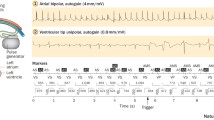Background:
Atrial fibrillation is the most frequently encountered sustained arrhythmia in clinical practice. To date, therapy of paroxysmal atrial fibrillation (AF) has been mainly directed to prevent AF recurrences. In the initial step, pharmacological treatment is the therapy of primary choice. Frequent inefficacy, side effects and the proarrhythmic risk in a growing number of patients has led to the development of nonpharmacological treatment strategies, as in the treatment of all other supraventricular tachycardias.
Aims of the studies: Catheter ablation procedures, atrial defibrillators and preventive atrial pacing are studied within prospective clinical trials. The concept of atrial pacing is based on the hypothesis, that influencing the trigger mechanisms of atrial fibrillation, e.g. bradycardia, atrial extrasystole, inter- and intraartrial conduction blocks and delays, could potentially prevent atrial fibrillation.
Results: Results from pacing studies in patients with sick sinus syndrom suggest a possible role for successful prevention; large prospective clinical trials including patients with paroxysmal atrial fibrillation are ongoing.
Conclusions: The questions whether pacing should be done biatrially or with two electrodes in the right atrium, or whether one electrode is sufficient and if so, where this electrode should be placed, are currently studied. Furthermore, pacing algorithms specifically targeting arrhythmogenic substrates need to be defined.
Hintergrund:
Vorhofflimmern stellt die häufigste anhaltende Rhythmusstörung in der klinischen Praxis dar. Die Therapie des paroxysmalen Vorhofflimmerns, richtet sich heute hauptsächlich auf die Prävention rekurrenter Flimmerepisoden. Strategie der Wahl ist hierbei zunächst die pharmakologische Therapie; häufige Ineffektivität, Nebenwirkungen und die Gefahr von Proarrhythmien stimuliert auch hier, wie bei der Behandlung aller anderen supraventrikulären Tachykardien, die Entwicklung nichtmedikamentöser alternativer Therapieverfahren.
Studienziele: Im Rahmen klinischer Studien werden derzeit Katheter-Ablationsverfahren, atriale Defibrillatoren und die präventive Vorhofstimulation untersucht. Das Konzept der Vorhofstimulation basiert auf der Hypothese, daß eine Beeinflussung der Auslösemechnismen von Vorhofflimmern, wie Bradykardie, atriale Extrasystolen, inter- und intraatriale Leitungsblockierungen oder Leitungsverzögerungen, präventiv wirksam sein könnte.
Ergebnisse: Ergebnisse von Schrittmacherstudien bei Patienten mit Sick-Sinus-Syndrom lassen auf eine mögliche erfolgreiche Prävention schließen. Große prospektive Studien bei Patienten mit paroxysmalem Vorhofflimmern als Indikation werden derzeit durchgeführt.
Schlußfolgerungen: Offen ist derzeit die Frage, ob biatrial oder mit zwei Sonden rechtsatrial stimuliert werden sollte oder ob eine rechtsatriale Elektrode ausreicht und wenn ja, wo diese plaziert werden sollte. Des weiteren sind Stimulationsalgorithmen, die spezifisch auf arrhythmogene Substrate zielen, zukünftig zu definieren.
Similar content being viewed by others
Author information
Authors and Affiliations
Rights and permissions
About this article
Cite this article
Hoffmann, E., Janko, S., Dorwarth, U. et al. Prävention von Vorhofflimmern durch atriale Stimulation. Herzschr Elektrophys 10 (Suppl 2), S053–S057 (1999). https://doi.org/10.1007/s003990050114
Issue Date:
DOI: https://doi.org/10.1007/s003990050114




